MXA RACE TEST: THE REAL TEST OF THE 2025 KAWASAKI KX450
Q: FIRST AND FOREMOST, IS THE 2025 KX450 BETTER THAN THE 2024 KX450?
A: It is certainly not a no, but it would be a stretch to say that the 2025 Kawasaki KX450 overshadows the 2024 KX450. We will say that having a year to analyze where they went wrong in 2024 gave the Kawasaki engineers a golden opportunity to fix some of their most grievous mistakes.
The 2024 KX450 had an all-new frame, all-new engine, all-new bodywork, all-new electronics, all-new front brake, all-new airbox, all-new frame geometry, all-new electronic package and all-new price tag. It stood a fairly high chance of suffering from the “first-year model” curse—and it did! They weren’t terminal bugs, quirks and gremlins, but they definitely were debilitating.
Before MXA gets to the performance evaluation of the 2025 KX450, let’s take a closer look at the issues that rang alarm bells in 2024 and the steps that Kawasaki’s engineers took to address them for 2025.
Q: WHAT WERE THE BUGABOOS, GREMLINS AND FLAWS THAT KAWASAKI FOCUSED ON FIXING FOR 2025?
A: None of the 2024 issues were deal-breakers; they were more like disappointments. But, to Kawasaki’s credit, they made an effort to address the flaws for 2025. What Kawasaki didn’t fix, the aftermarket tried to address. Below is a series of questions and how Kawasaki answered them in 2025.

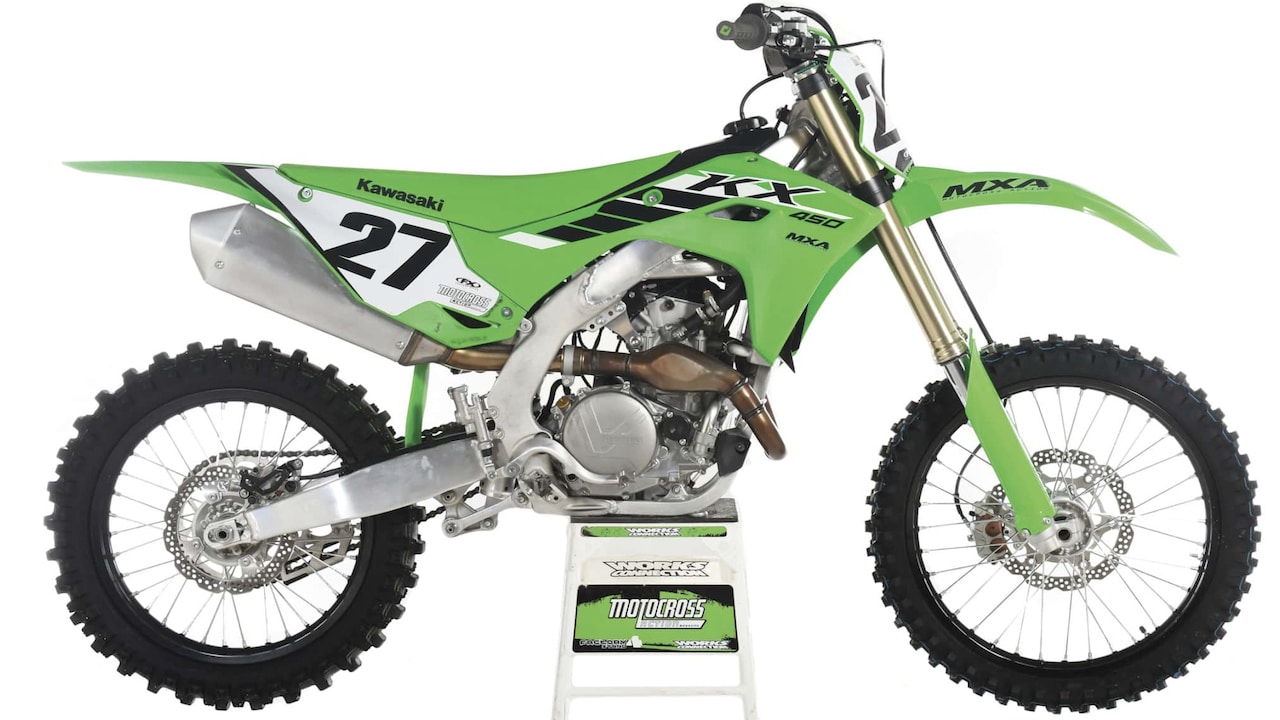 The 2025 Kawasaki KX450 is identical to the 2024 model—with the exception of a few tweaks.
The 2025 Kawasaki KX450 is identical to the 2024 model—with the exception of a few tweaks.
Q: WHAT HAPPENED TO KAWASAKI’S HORSEPOWER HERITAGE?
A: For 2024, the KX450 engine got some very contemporary updates. The cylinder head housed a new center-port exhaust, which required a new frame to allow the exhaust pipe to exit straight forward. The center-port design enabled the intake tract, intake valves, exhaust valves and throttle body to align themselves in a straight run from the downdraft intake routing to the combustion chamber. The 2024 intake camshaft was raised 7mm to make room for the straight-line intake tract. Kawasaki’s engineers long-rodded the engine with a 5mm-longer connecting road.
 The new frame required split down tubes to accommodate the center port cylinder design.
The new frame required split down tubes to accommodate the center port cylinder design.
All of these updates were praiseworthy, but for all of the changes, the 2024-2025 KX450 did not deliver a corresponding increase in horsepower. It was—and still is—slower than the engine specs would predict. It ranks fifth in the horsepower derby at 58.01 horsepower, which is a big deficit to the class-leading 60.1 horsepower of the Big Dogs in the 450 class. The problem wasn’t the actual horsepower number but the fact that the bike felt slow and didn’t respond quickly.
Kawasaki’s spokesmen said that they were not chasing peak horsepower in 2024; instead, they were looking for a broader, easier-to-use powerband that suited the majority of 450 riders. They achieved that, but what they left off the table was the power that differentiates a race bike from a trail bike or an off-road bike. Kawasaki left that to the aftermarket.
Q: WHAT DID THE KX450 GIVE TO GET IN THE HANDLING DEPARTMENT?
A: Most MXA test riders like the changes that Kawasaki made to the frame geometry. The 1-degree-steeper head angle (from 27.6 degrees to 26.6 degrees) and reduced trail (4.8 inches to 4.5 inches) deliver quicker steering, but as anyone who has chased quicker steering finds out, there is a price to pay. First, there is the twitch of over-steer at turn-in; second, there is a degradation of high-speed stability that manifests as head-shake. Achieving sharp cornering without losing straight-line stability is a give-and-take proposition. There are backyard fixes for both handling issues—and, of course, more expensive aftermarket cure-alls.
Little known to the average consumer was that the 2024 Kawasaki KX450 frame suffered cracks to the tubing closest to the footpeg/subframe area. That has been fixed for 2025, and a dealer bulletin has addressed the issues for owners of 2024 KX450s.
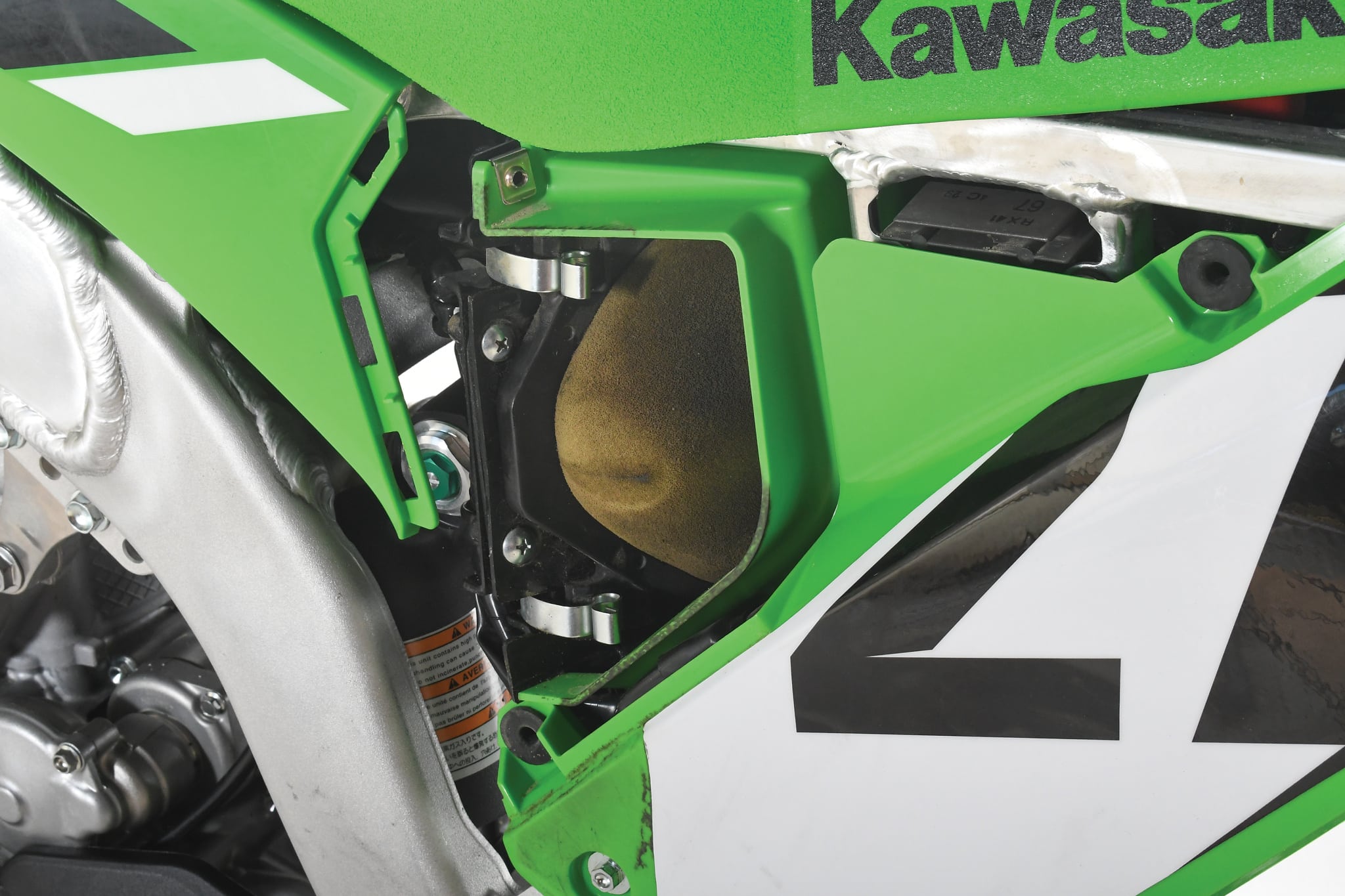 A dome-shaped air filter replaces last year’s “flat piece of toast” air filter.
A dome-shaped air filter replaces last year’s “flat piece of toast” air filter.
Q: WHAT WAS KAWASAKI THINKING WITH ITS AIRBOX DESIGN?
A: We fully understand that every brand is trying to offer easier-to-use airbox access and quicker-to-install air filters. The fastest way to achieve this is to copy the KTM system. For 2024, Kawasaki elected to combine KTM’s “no tools” airbox cover with Yamaha’s “flat piece of toast” air filter in a design with a very small airbox volume, which had to be band-aided by the “rubber plug.” It was a very poorly thought-out combination that literally killed throttle response and overall power.
Again, the aftermarket stepped in to offer airbox fixes and enlarged air-filter elements. For 2025, the KX450 gets a larger-domed air filter (borrowed from a Twin Air design); however, the domed filter takes up additional room in the already-small airbox and thus does little for the power picture.
 The 2024-2025 Kawasaki KX450 is the first KX450 in years that can actually dive into inside lines with a vengeance.
The 2024-2025 Kawasaki KX450 is the first KX450 in years that can actually dive into inside lines with a vengeance.
Q: DID YOU KNOW THE HIDDEN SECRET OF THE KX450’S ECU?
A: On the 2024 model, Kawasaki introduced a communication module mounted to the left rear frame rail that allowed KX450 owners to connect wirelessly to Kawasaki’s Rideology app from their smartphones. Once connected, the rider could make his own fuel and ignition maps using Kawasaki’s six-by-six grid. That sounds good, but it didn’t work so well. Competing brands allow you to customize and upload two maps into the ECU that can be easily switched between with the map switch. On the KX450, you can customize a map and upload it, but then the “light off” position is that map and the “light on” position is a detuned version of that same map.
For 2025, the Kawasaki Rideology app will have wider parameters to allow more leeway in designing your own maps. MXA preferred to have Twisted Development map a Vortex ignition for us. That was one of the best KX450 mods we made to the powerband.
Q: DO YOU THINK THE RM-Z450 IS THE HEAVIEST BIKE IN THE 450 CLASS?
A: Guess again. Somehow, the 2024 Kawasaki KX450 gained 5 pounds. It went from 234 pounds in 2023 to 239 pounds in 2024—and it stays in that same weight class for 2025. Oh, maybe it is a hair lighter than that because Kawasaki dropped the rubber plug from the airbox. It is now in a tie for the heavyweight championship of the 450 class with the Suzuki RM-Z450 (not the stock RM-Z450, but the RM Army model with the lighter Pro Circuit exhaust system).
Q: YOU PAY THE PRICE, AND SO DOES KAWASAKI.
A: Obviously, we expect the price of any all-new model to be higher, but we don’t expect the price to jump from $9599 in 2023 to $10,399 in 2024 and $10,499 in 2025. That is a $900 price increase. And when you combine inflation with the KX450’s bugaboos, gremlins and flaws, you get poor sales. By year’s end, Kawasaki was selling 2024 KX450s for $5999 because the dealerships had leftover stock. That is a $4400 price reduction.
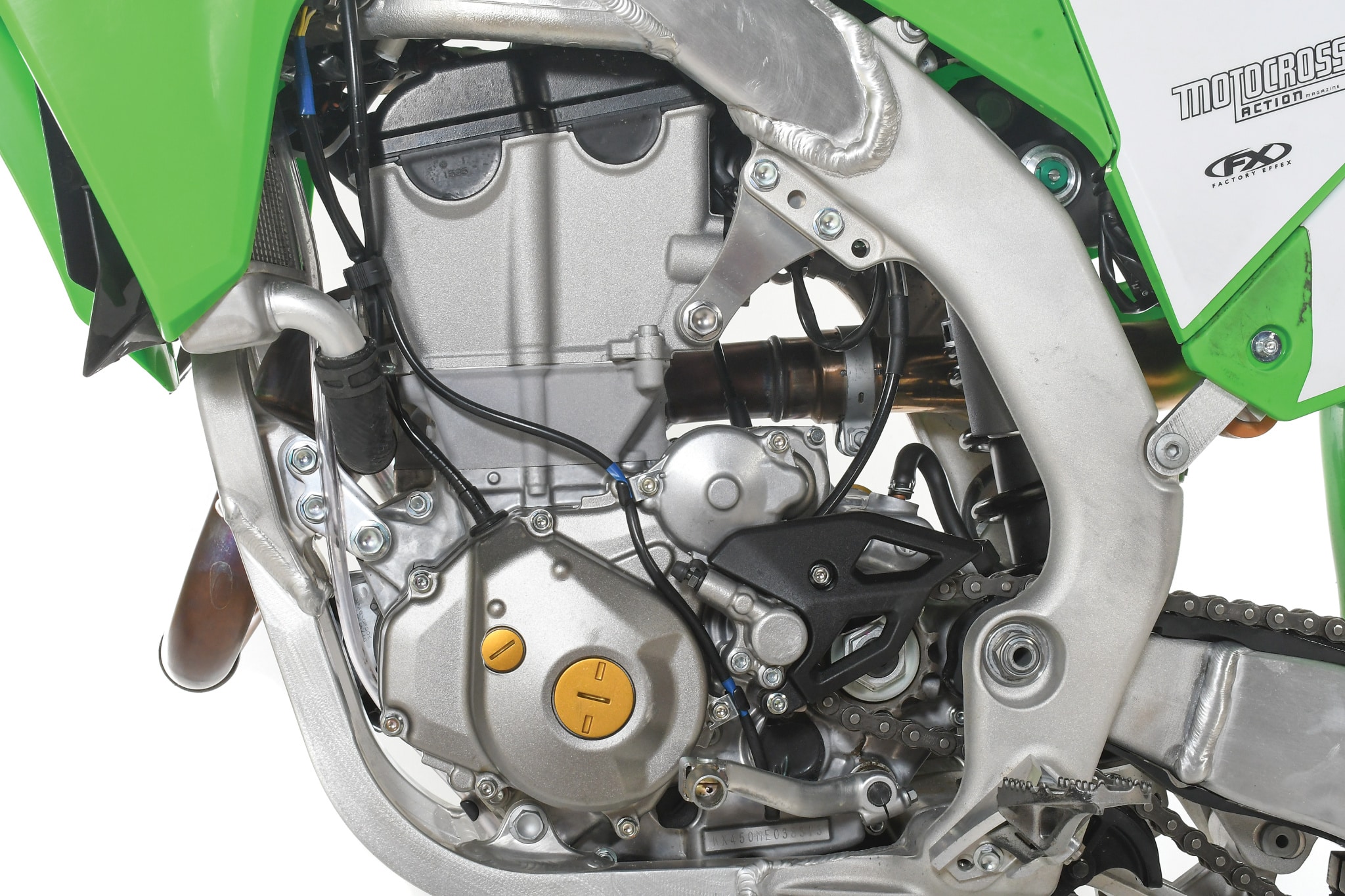 Traditionally, Kawasaki has a reputation for building broad, powerful and class-leading horsepower; the 2024–2025 engine is not traditional.
Traditionally, Kawasaki has a reputation for building broad, powerful and class-leading horsepower; the 2024–2025 engine is not traditional.
Q: WHAT’S NEW ON THE SUSPENSION?
A: The workhorse 49mm Showa coil-spring forks used on the KX450, RM-Z450 and CRF450 have never reached their full potential on any of the three brands spec’ing them, but for 2025, Kawasaki has come the closest to spec’ing valving and internal changes that allow the forks to roll off the assembly line ready to race. Okay, maybe not by fast intermediates or pros, but certainly by Kawasaki’s target audience of vets and novices.
Visually, the only major change is that the trick-looking DLC coating on the fork tubes is gone and replaced by a downsized internal free piston that reduces stiction, which used to be the job of the DLC coating. With a claimed 80-percent reduction in the friction coefficient, thanks in large part to an improved O-ring material, the expensive coating is not necessary; however, when friction is reduced, so is damping, which is why the KX450’s Showa forks lean towards the soft side and feel pitchy in the bumps. Don’t be afraid to dial in more compression damping, and if you have bottoming issues, add 10cc of oil to each leg or up the spring rate.
On the rear suspension, Kawasaki revised the rising-rate linkage to work in conjunction with the shock. As an added touch, Showa honed the inner diameter of the shock body to ensure accurate roundness and reduce stiction friction. Kawasaki claims that the honing process reduced shock stiction by 25 percent.
Q: WHAT MODIFICATIONS DID WE MAKE TO IMPROVE THE 2025 KX450?
A: For a lot of motocross racers, the best bike is the one that they don’t have to spend more money on after it leaves the showroom floor. This is an expensive sport, and there should be no reason to make it more expensive. The MXA wrecking crew tries to fix every flaw with common-sense solutions, but when we can’t do it ourselves, it gets pricey. Here is what we did to our 2024–’25 Kawasaki KX450s.
(1) Horsepower. MXA ran a Pro Circuit exhaust system. Why wouldn’t we? It is what Team Kawasaki runs. We had Twisted Development map a Vortex ignition system for us to pep up the complete powerband.
(2) Head-shake. If your KX450 shakes at speed, especially in the braking bumps at the end of a long straight or coming down a big hill, you can fix it by simply sliding your fork legs down into the triple clamps. How far down? That depends on how much it shakes. Some MXA test riders make the fork caps flush with the top of the triple clamp. Some come up 2mm.
Another way to increase high-speed stability is to add four links to your chain and move the rear wheel as far back as it can go. The longer wheelbase moves the engine forward to put more weight on the front wheel to help keep it from dancing.
(3) Third-gear bog. The 2024–’25 KX450 has a weird gearbox. Second gear is very long and on certain tracks feels like third gear, but it often bogs when you shift to third gear, especially under a load. Our solution was to change out the 50-tooth stock rear sprocket for a 51-tooth sprocket (we did this when adding links to the chain). The lower gear helps us get on top of third gear sooner.
(4) Chain guide. Kawasaki has made modest improvements to the stock chain guide, but we wore through it in 10 hours of riding. We switched to a TM Designworks Factory Edition Slide ’n’ Guide kit. It lasts forever.
(5) Vibration. The KX450 is a vibrator. There is a lot of feedback through the handlebars. We used FCP engine mounts and head stays to cut down on vibration.
 It makes respectable horsepower on the dyno, but the feel on the track is that the KX450 is slow
It makes respectable horsepower on the dyno, but the feel on the track is that the KX450 is slow
Q: HOW DOES THE 2025 KAWASAKI KX450 RUN ON THE TRACK?
A: We wish that Kawasaki had pursued peak horsepower and increased torque a little more aggressively, because over the last 50 years Kawasaki has been known for making engines that produced beaucoup horsepower—the 2012 model year comes to mind. They could have made much more top-end power without losing that broad, easy-to-use power they said they were aiming for. A classic example is the 2024 Husqvarna FC450. It delivers a nice, pleasant, brisk, nonconfrontational vet style of power but peaks at a class-leading 61.18 horsepower.
People who don’t race always say, “No one can use all the power that a 450cc motocross bike puts out.” Obviously, they have never tried to get a holeshot. Every rider, by the time he is halfway to the first turn, wishes his bike had 5 more horsepower. The same is true for climbing big hills, blasting down a deep sand straight or coming out of a corner side by side with a guy on a more powerful bike. The 2024–’25 KX450 is at a disadvantage in all of these situations.
More power would help the 2025 KX450 immensely. KX450 owners can find that power in the aftermarket, but wouldn’t it be nice if they didn’t have to?
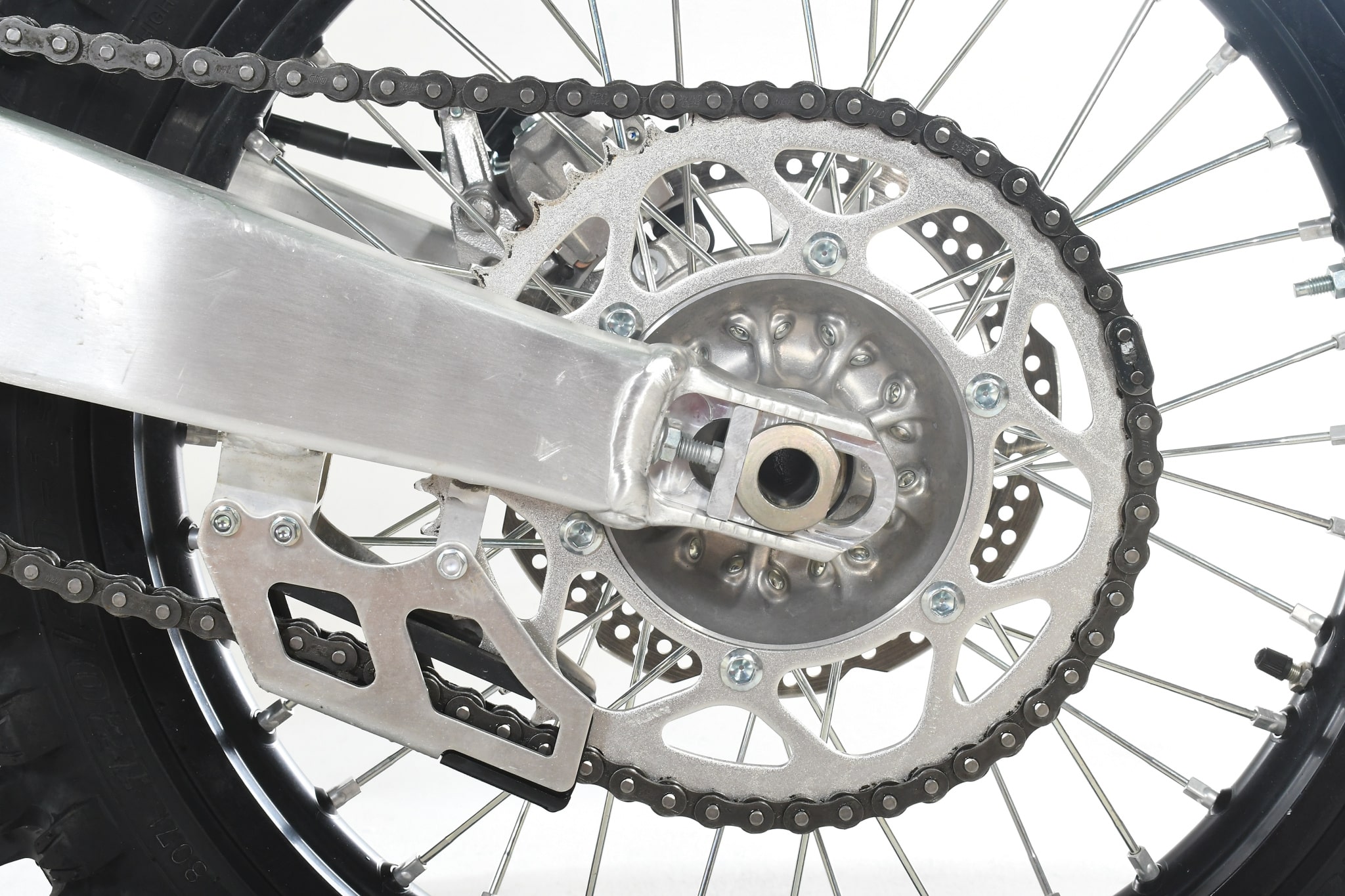 MXA added a tooth to the rear sprocket to help the KX450 get on top of third gear quicker.
MXA added a tooth to the rear sprocket to help the KX450 get on top of third gear quicker.
Q: HOW DOES THE 2025 KAWASAKI KX450 HANDLE?
A: As much as Kawasaki built a reputation for making powerful, broad and torquey powerbands, they were also known for producing a stable, pedestrian, upright-handling chassis. They didn’t have bad handling, but they didn’t have great handling, either. The all-new generation of KX450 frames mate aggressive turn-in with acceptable high-speed stability. We know from experience that getting sharp cornering without compromising straight-line stability is a balancing act.
The 2024–’25 Kawasaki KX450 turns light years better than it has in the past; however, it does want to oversteer into corners if the rider gets sloppy, and, by the same token, it also suffers from serious head-shake at speed.
Oversteer and head-shake are not traits that defined previous KX450s, but when you steepen the head angle by a full degree, you give to get. Both of these negative traits are fixable with careful chassis setup, but if Kawasaki wants to sell bikes to today’s audience, they need a bike that knifes through tight turns. Kawasaki is offering what its customers want.
Q: WHAT DID WE HATE?
A: The hate list:
(1) Airbox. Engines are nothing more than air pumps. They pump air into the combustion chamber and pump air out through the exhaust system. If delivered in the correct quantity, air is a thing of beauty. The 2024 KX450 airbox is not a thing of beauty.
(2) Weight. The 2024 Kawasaki KX450 weighs 239 pounds without gas in the tank. That is heavy.
(3) Plastic. The fork guards will break if roosted with rocks. Kawasaki’s plastic is the most brittle of all the brands. We get fork-guard graphics, not because we want graphics on the fork guards, but because they help keep them from cracking.
(4) Bar-mount twist. If you fall over, your bar mounts will twist. You might think that you have bent the bars, but you haven’t. It is just the bar mounts. Loosen the bolt underneath and twist them back into place.
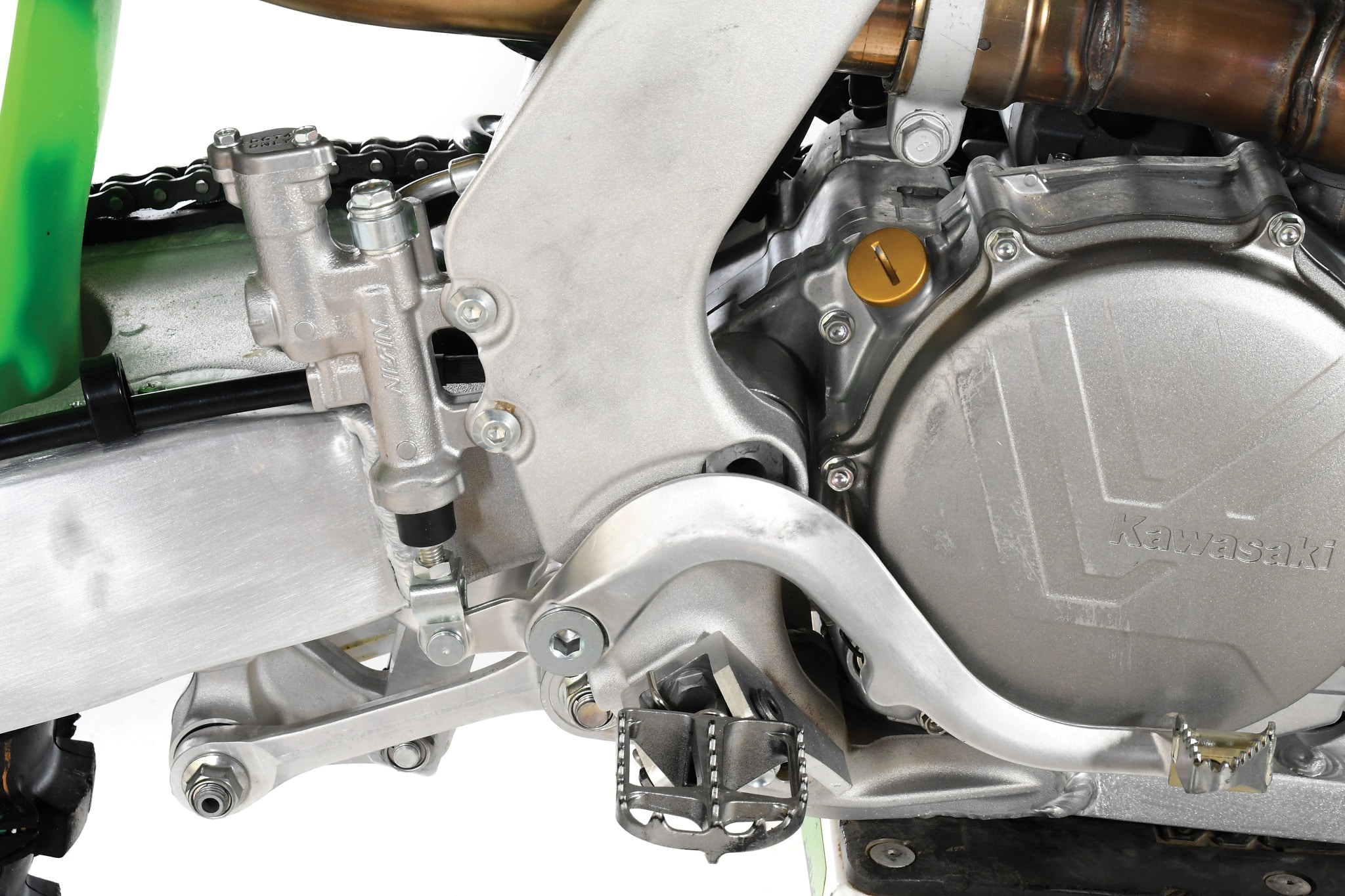 The oil-filler cap requires a large flat-bladed screwdriver to take it off. Order an aftermarket cap that can be removed by hand or with a wrench.
The oil-filler cap requires a large flat-bladed screwdriver to take it off. Order an aftermarket cap that can be removed by hand or with a wrench.
Q: WHAT DID WE LIKE?
A: The like list:
(1) Power-mode switch. We like that we don’t have to juggle plug-in couplers anymore. You can change maps at the handlebar switch—an idea that was obviously borrowed from Honda. The KX features two engine maps (stock and mellow), plus traction control and launch control. The ECU offers a larger update window than it did in 2024, but it still doesn’t have as much as many riders would like
(2) Brembo. Somebody at Kawasaki is brilliant. Spec’ing a complete Brembo front brake system was a stroke of genius. It is a great front brake.
(3) Bodywork. Kawasaki has never been known for sleek bodywork, great ergonomics or a seamless interface, but the new lime green plastic is a big step up in design.
(4) Handling. This is the first Kawasaki in recent memory that actually wants to turn.
(5) Footpegs. The KX450F footpegs can be moved down 5mm if you so desire. On the new chassis, the lower position felt better.
(6) Bar mounts. The bars can be adjusted to four different locations. They come stock in the front holes with the bar mounts swiveled rearward, but most MXA test riders run the bar mounts in the rearward holes with the bars swiveled forward.
(7) Grips. Thankfully, Kawasaki has stopped vulcanizing their grips to the bars. The new ODI lock-on grips make changing grips much easier.
(8) Rear hub. The new rear hub is now 58mm wide; it was 46mm wide. The wider span increases rear-wheel strength.
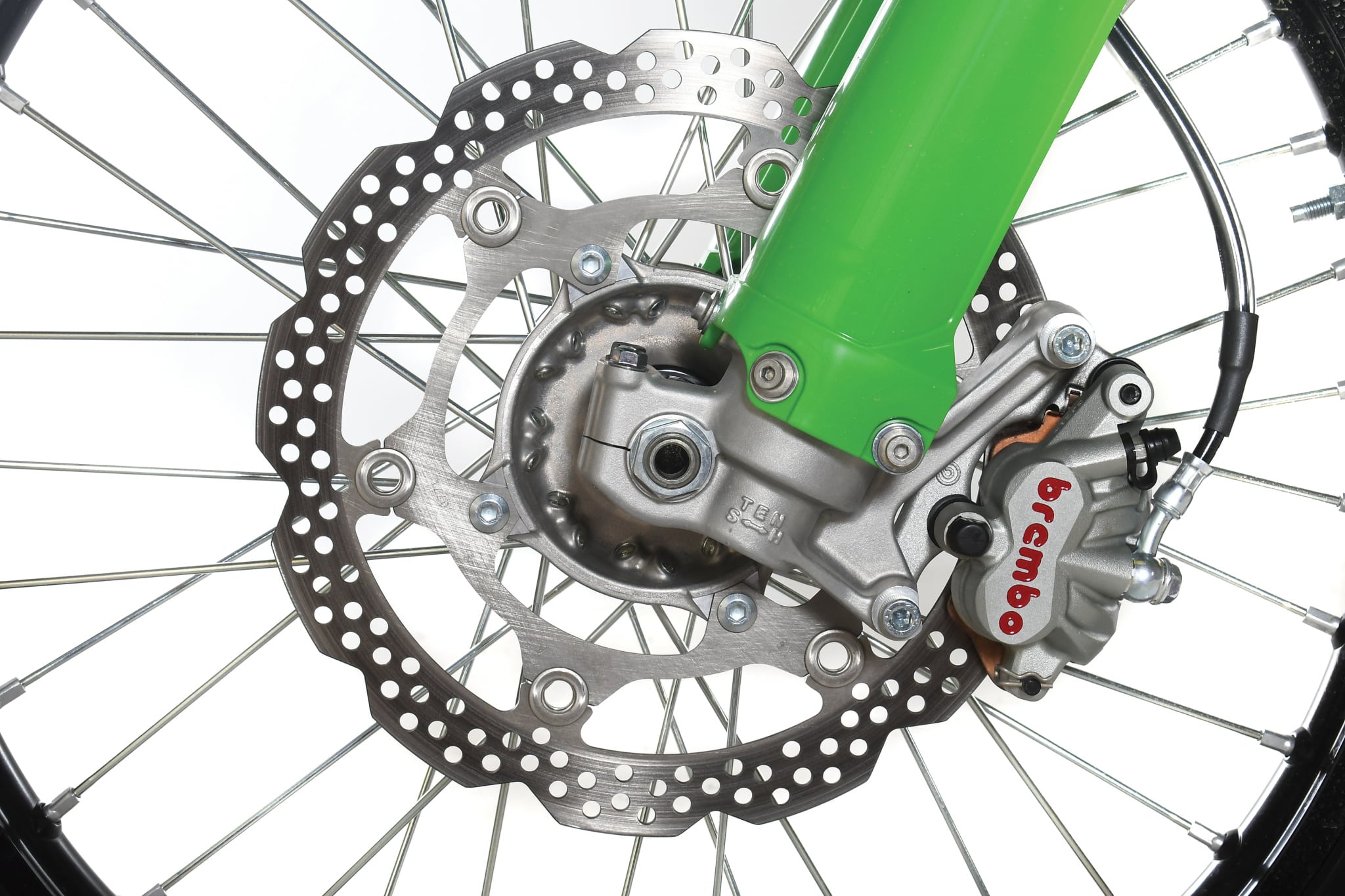 The Brembo front brake is a big step up for Kawasaki pucker power.
The Brembo front brake is a big step up for Kawasaki pucker power.
Q: WHAT DO WE REALLY THINK OF THE 2025 KAWASAKI KX450?
A: If you were among the racers who saw that Kawasaki dropped the price of the leftover 2024 KX450s by $4400, you got a great deal. Even if your friendly local dealer hit you up for shipping fees, setup charges and a hokey $1000 upcharge, you still saved enough money to buy everything you need to make the 2024 into a 2025.


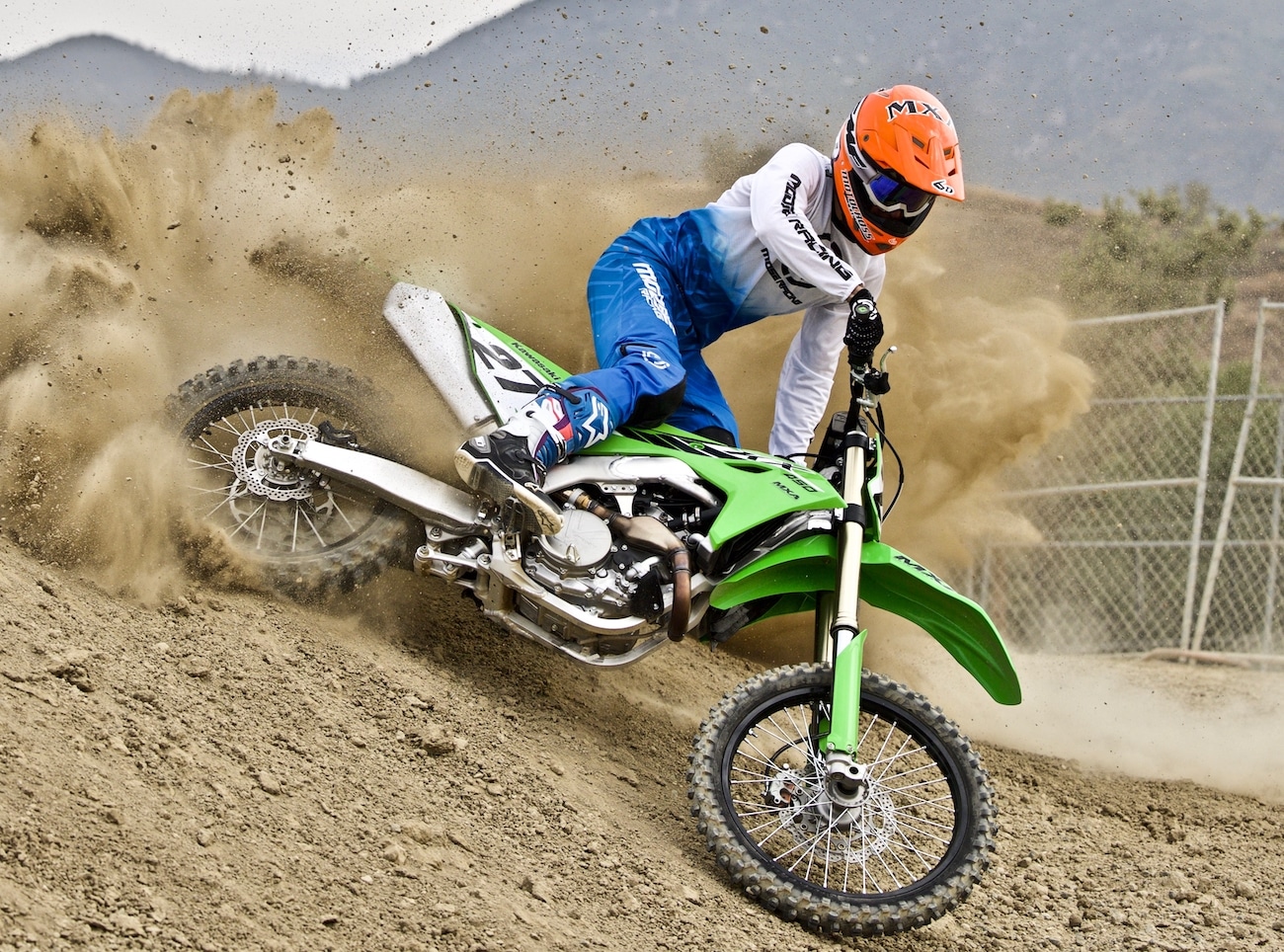

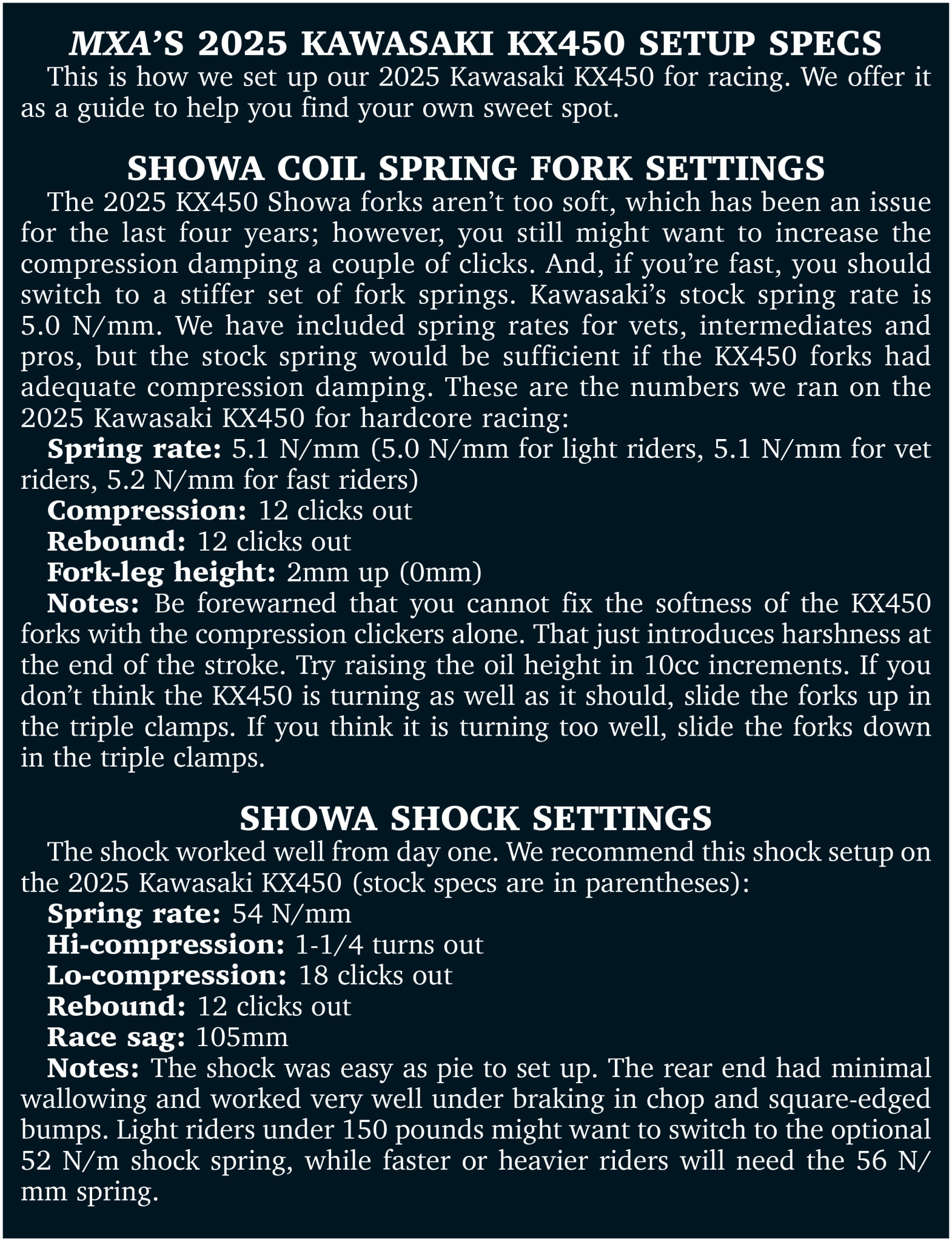




Comments are closed.